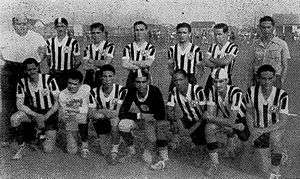Goiânia Esporte Clube
 | |||
| Full name | Goiânia Esporte Clube | ||
|---|---|---|---|
| Nickname(s) | Galo Carijó | ||
| Founded | July 5, 1938 | ||
| Ground |
Olímpico Pedro Ludovico, Goiânia, Brazil | ||
| Capacity | 10,000 | ||
| Chairman | Raulindo Heinzelman Naves | ||
|
| |||
Goiânia Esporte Clube, or Goiânia as they are usually called, are a Brazilian football team from Goiânia in Goiás state, founded on July 5, 1938.[1] Their home stadium is the Olímpico Pedro Ludovico, which has a maximum capacity of 10,000 people.[2] They play in black and white shirts, white shorts and black socks. Goiânia competed several times in the Série A. The club have the fourth largest fan base in the state.[3]
History

Goiânia Esporte Clube were founded on July 5, 1938,[1] and it is the oldest club of the state of Goiás.[4] The club won the Campeonato Goiano in 1945, 1946, 1948, 1950, 1951, 1952, 1953, 1954, 1956, 1958, 1959, 1960, 1968 and 1974.[1] However, after the Estádio Serra Dourada was inaugurated, Goiânia never won the state championship again.[5] They won the Copa Brasil Central in 1967, and the Campeonato Goiano Second Level in 1998 and in 2006.[3]
The first time the club competed in the Série A was in 1975,[6] when they finished were eliminated in the first stage.[7] In 1976, they were again eliminated in the first stage,[8] being eliminated in the first stage again in 1977,[9] and in 1979.[10] Goiânia also competed in the Copa João Havelange, in 2000, when they were eliminated in the White Module's first stage.[11]
Goiânia competed twice in the Copa do Brasil.[6] The first time was in 1991, when they were eliminated in the first round by Fluminense de Feira.[12] The second time was in 2001, when they beat América Mineiro in the first round, but were eliminated by Corinthians in the second round.[13]
Achievements
- Copa Brasil Central:
- Winners (1): 1967
- Campeonato Goiano:
- Winners (14): 1945, 1946, 1948, 1950, 1951, 1952, 1953, 1954, 1956, 1958, 1959, 1960, 1968, 1974
- Campeonato Goiano Second Level:
- Winners (2): 1998, 2006
Stadium
Goiânia play their home games at Olímpico Pedro Ludovico, located in Goiânia.[6] The stadium has a maximum capacity of 10,000 people, and was inaugurated on September 3, 1941.[2]
Rivals
The rivalry between Goiânia and Atlético Goianiense is the oldest of the state.[5] The derby against Goiás is known as Clássico Go-Go.[14] Vila Nova is another rival.[14]
References
- 1 2 3 "Goiânia Esporte Clube" (in Portuguese). Federação Goiana de Futebol. Retrieved February 23, 2009.
- 1 2 "Estádio Olímpico Pedro Ludovico" (in Portuguese). Templos do Futebol. Retrieved February 23, 2009.
- 1 2 "Governador Marcelo Miranda é homenageado pelo Goiânia" (in Portuguese). Futebol do Norte. January 16, 2007. Retrieved February 23, 2009.
- ↑ "Primeiro clube de Finazzi está abandonado" (in Portuguese). Globo Esporte. November 11, 2007. Retrieved February 23, 2009.
- 1 2 "Atlético x Goiânia" (in Portuguese). Clássicos do Futebol Brasileiro. Retrieved February 23, 2009.
- 1 2 3 "Goiânia Esporte Clube". Arquivo de Clubes. Retrieved February 23, 2009.
- ↑ "I Copa Brasil – 1975". RSSSF. July 26, 2000. Archived from the original on March 2, 2009. Retrieved February 23, 2009.
- ↑ "II Copa Brasil – 1976". RSSSF. May 27, 2007. Archived from the original on January 26, 2009. Retrieved February 23, 2009.
- ↑ "III Copa Brasil – 1977". RSSSF. October 31, 2000. Archived from the original on January 26, 2009. Retrieved February 23, 2009.
- ↑ "V Copa Brasil – 1979" (in Portuguese). RSSSF. November 16, 2007. Archived from the original on March 27, 2009. Retrieved February 23, 2009.
- ↑ "Brazil 2000 Championship – Copa João Havelange". RSSSF. June 6, 2008. Archived from the original on January 31, 2009. Retrieved February 23, 2009.
- ↑ "Brazil Cup 1991". RSSSF. October 13, 1999. Archived from the original on February 1, 2009. Retrieved February 23, 2009.
- ↑ "Brazil 2001 Cup". RSSSF. August 3, 2007. Archived from the original on March 2, 2009. Retrieved February 23, 2009.
- 1 2 "Goiânia x Goiás" (in Portuguese). Clássicos do Futebol Brasileiro. Retrieved February 23, 2009.